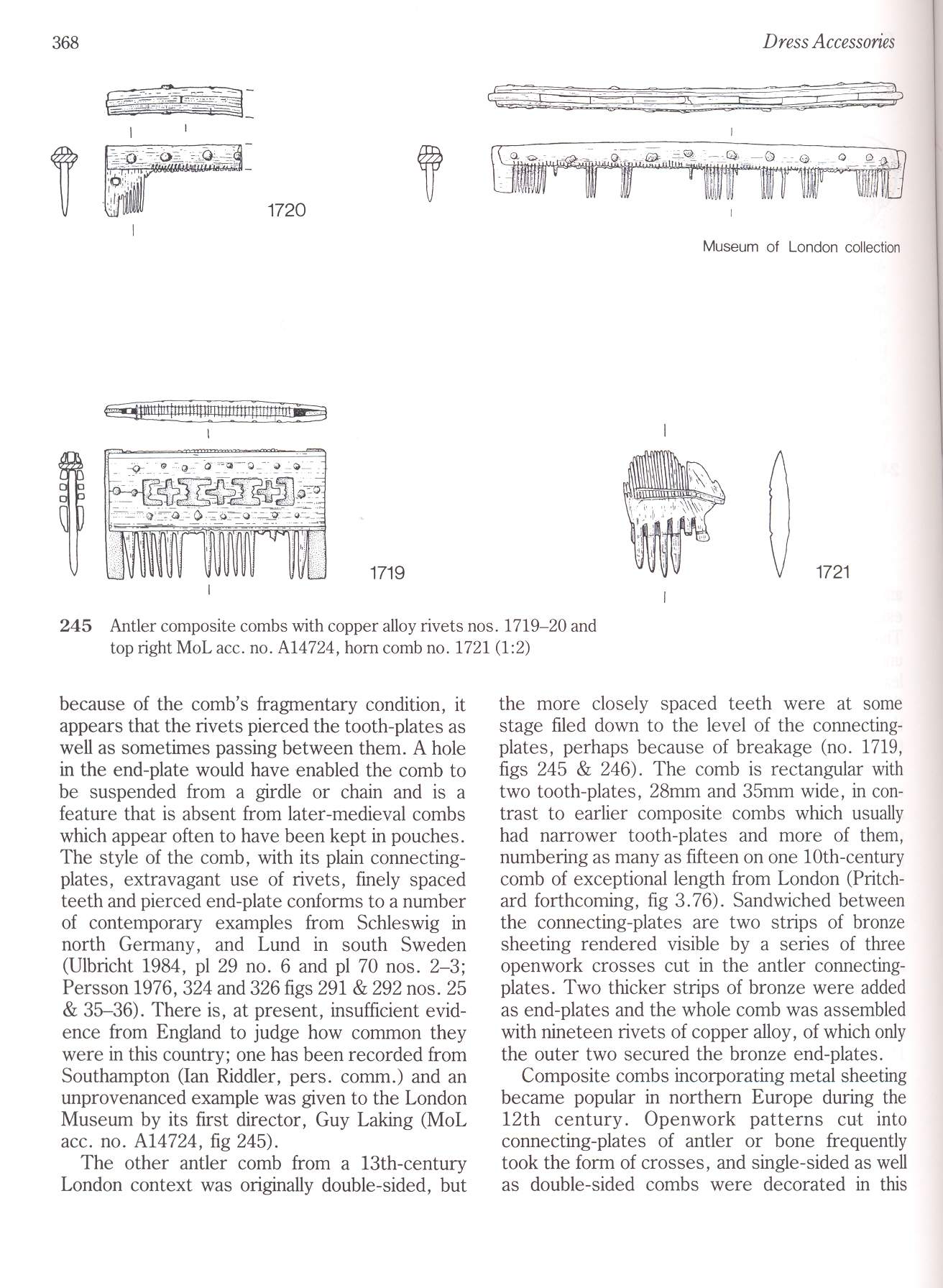395 (13)

368
Dress Accessońes


245 Antler composite combs with copper alloy rivets nos. 1719-20 and top right MoL acc. no. A14724, hom comb no. 1721 (1:2)
because of the comb’s fragmentary condition, it appears that the rivets pierced the tooth-plates as well as sometimes passing between them. A hole in the end-plate would have enabled the comb to be suspended from a girdle or chain and is a feature that is absent from later-medieval combs which appear often to have been kept in pouches. The style of the comb, with its plain connecting-plates, extravagant use of rivets, finely spaced teeth and pierced end-plate conforms to a number of contemporary examples from Schleswig in north Germany, and Lund in south Sweden (Ulbricht 1984, pl 29 no. 6 and pl 70 nos. 2-3; Persson 1976, 324 and 326 figs 291 & 292 nos. 25 & 35-36). There is, at present, insufficient evid-ence from England to judge how common they were in this country; one has been recorded from Southampton (łan Riddler, pers. comm.) and an unprovenanced example was given to the London Museum by its first director, Guy Laking (MoL acc. no. A14724, fig 245).
The other antler comb from a 13th-century London context was originally double-sided, but
the morę closely spaced teeth were at some stage filed down to the level of the connecting-plates, perhaps because of breakage (no. 1719, figs 245 & 246). The comb is rectangular with two tooth-plates, 28mm and 35mm wide, in con-trast to earlier composite combs which usually had narrower tooth-plates and morę of them, numbering as many as fifteen on one lOth-century comb of exceptional length from London (Pritch-ard forthcoming, fig 3.76). Sandwiched between the connecting-plates are two strips of bronze sheeting rendered yisible by a series of three openwork crosses cut in the antler connecting-plates. Two thicker strips of bronze were added as end-plates and the whole comb was assembled with nineteen rivets of copper alloy, of which only the outer two secured the bronze end-plates.
Composite combs incorporating metal sheeting became popular in northem Europę during the 12th century. Openwork patterns cut into connecting-plates of antler or bonę freąuently took the form of crosses, and single-sided as well as double-sided combs were decorated in this
Wyszukiwarka
Podobne podstrony:
355 (20) Dress Accessońes 328 216 Finger rings with glass settings, except nos. 1616,1617,1619 &
397 (13) 370 Dress Accessońes piąte were held securely in position (fig 247). A further feature of t
393 (13) 366 Dress AccessoriesCombs Three out of the four basie comb forms as defined by Patricia Ga
416 (14) 389Metallurgical Analysis of the Dress Accessories Lead Lead Fig 258 Ali copper alloys. Eac
302 (41) 274 Dress Accessońes buttons of the former kind, found in Lund in Sweden). Composite sheeti
422 (13) Metallurgical Analysis of the Dress Accessories site form which include a forked spacer san
431 (10) 404 Dress Accessońes —, 1987 ‘Report on the Composition of the Ingots and Axle-Cap’, in Mea
img028 (13) ulna lig. accessorloulnarc lig. radiocarpeum palmare os carpi ulnare o: carpi accessori
274 (42) Dress Accessońes 246 1078 805 1095 (A) mounts with fields of dots (1:1) (
276 (40) 248 Dress Accessońes because no indication has been recognized on them of the wearer’s adhe
278 (40) 250 Dress Accessories 1314 1311 SWA81 2186 (2055) 9 fig 160 Corroded
284 (41) 256 Dress Accessońes Hooked annular brooch Copper alloy 1338 SWA81 acc. no. 1493 (context
286 (34) 258 Dress Accessońes 166 Pentagonal, hexagonal and six-lobed brooches -odginał shapes resto
292 (37) 264 Dress Accessories 1365 171 Yiolet brooches (drawings 1:1, photograph 2:1) (?)flower bud
296 (37) 268 Dress Accessońes Brooches with circular frames Leaf 1374 BC72 2037 (83) 11 fig 174 Poss
298 (39) 270 Dress Accessories Table 5 Brooches - metals used 1 1 Copper i i 2 I I I -1-1—[— 1 1 1
304 (37) 276 Dress Accessońes slightly damaged (an impressed dot here may not be an original feature
306 (35) 180 180 278 Dress Accessońes Cloth buttons and corresponding holes on a sleeve from a depos
308 (39) 280 Dress Accessońes late 13th century onwards. The alloys used in buttons prior to that co
więcej podobnych podstron